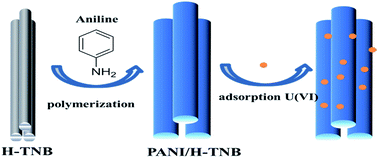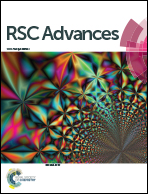Efficient removal of U(vi) from aqueous solutions by polyaniline/hydrogen-titanate nanobelt composites
Abstract
The organic–inorganic hybrid material of polyaniline/hydrogen-titanate nanobelt (PANI/H-TNB) composites was fabricated through a convenient oxidative polymerization approach. The characteristic results of X-ray powder diffraction and Fourier transformed infrared spectroscopy showed that aniline was successfully polymerized onto titanate surfaces. The adsorption capacity of PANI/H-TNB composites toward U(VI) was evaluated by batch experiments, and this adsorption process followed a pseudo-second order kinetics model and Langmuir model. The PANI/H-TNB composites showed a maximum adsorption amount of 216.82 mg g−1 toward U(VI), which was higher that of PANI (48.75 mg g−1) and many other adsorbents. The thermodynamic parameters calculated from the adsorption isotherms indicated a spontaneous and endothermic adsorption process. Higher adsorption capacities were observed after regeneration for six cycles. The PANI/H-TNB composites could be regarded as a potential adsorbent to remove U(VI) from wastewater.


 Please wait while we load your content...
Please wait while we load your content...